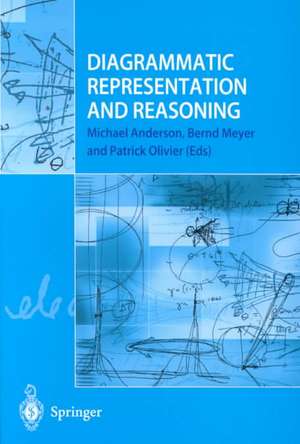Diagrammatic Representation and Reasoning
Editat de Michael Anderson, Bernd Meyer, Patrick Olivieren Limba Engleză Paperback – 4 oct 2001
Preț: 959.04 lei
Preț vechi: 1169.56 lei
-18% Nou
Puncte Express: 1439
Preț estimativ în valută:
183.54€ • 190.91$ • 151.52£
183.54€ • 190.91$ • 151.52£
Carte tipărită la comandă
Livrare economică 14-28 aprilie
Preluare comenzi: 021 569.72.76
Specificații
ISBN-13: 9781852332426
ISBN-10: 1852332425
Pagini: 604
Ilustrații: XVI, 584 p. 64 illus.
Dimensiuni: 155 x 235 x 32 mm
Greutate: 0.84 kg
Ediția:Softcover reprint of the original 1st ed. 2002
Editura: SPRINGER LONDON
Colecția Springer
Locul publicării:London, United Kingdom
ISBN-10: 1852332425
Pagini: 604
Ilustrații: XVI, 584 p. 64 illus.
Dimensiuni: 155 x 235 x 32 mm
Greutate: 0.84 kg
Ediția:Softcover reprint of the original 1st ed. 2002
Editura: SPRINGER LONDON
Colecția Springer
Locul publicării:London, United Kingdom
Public țintă
ResearchDescriere
Diagrams are essential in most fields of human activity. There is substan tial interest in diagrams and their use in many academic disciplines for the potential benefits they may confer on a wide range of tasks. Are we now in a position to claim that we have a science of diagrams-that is, a science which takes the nature of diagrams and their use as the central phenom ena of interest? If we have a science of diagrams it is certainly constituted from multiple disciplines, including cognitive science, psychology, artificial intelligence, logic, mathematics, and others. If there is a science of diagrams, then like other sciences there is an appli cations, or engineering, discipline that exists alongside the science. Applica tions and engineering provide tests of the theories and principles discovered by the science and extend the scope of the phenomena to be studied by gen erating new uses of diagrams, new media for presenting diagrams, or novel classes of diagram. This applications and engineering side of the science of di agrams also comprises multiple disciplines, including education, architecture, computer science, mathematics, human-computer interaction, knowledge ac quisition, graphic design, engineering, history of science, statistics, medicine, biology, and others.
Cuprins
Part I - Views of Diagrams: 1. Diagrams in the Mind?.- 2. Knowing about Diagrams.- 3. A Meta-Taxonomy for Diagram Research.- 4. Sketches as Mental Reifications of Theoretical Scientific Treatment.- 5. The Fundamental Design Variables of Diagramming. Part II - Cognitive Aspects of Diagrams: 6. Psychological Perspectives on Diagrams.- 7. Combining Semantic and Cognitive Accounts of Diagrams.- 8. Tactile Maps and a Test of the Conjoint Retention Hypothesis.- 9. Spatial Abilities in Problem Solving in Kinematics.- 10. Graph Comprehension: The Role of Format, Content and Individual Differences.- 11. Graphs in Print.- 12. The Role of Representation and Working Memory in Diagrammatic Reasoning and Decision-Making.- 13. Mechanical Reasoning about Gear-and-Belt Diagrams; Do Eye Movements Predict Performance?.- 14. How do Designers Shift their Focus of Attention in their own Sketches?. Part III - Formal Aspects of Diagrammatic Reasoning: 15. Diagrammatic Evaluation of Visual Mathematical Notations.-16. A Topological Framework for Modelling Diagrammatic Reasoning Tasks.- 17. Multiple Readings of Pierces Alpha Graphs.- 18. On Automating Diagrammatic Proofs of Arithmetic Arguments.- 19. On the Practical Semantics of Mathematical Diagrams.- 20. EnE Sentences and Local Extent.- 21. Implementing Euler/Venn Reasoning.- 22. Visual Spatial Query Languages: A Semantics Using Description Logic. Part IV - Applications of Diagrammatic Reasoning: 23. Intelligent Diagrammatic Interfaces: State of the Art.- 24.Towards Diagram Processing: A Diagrammatic Information System.- 25. Using Diagrams to Understand Diagrams: A Case-Based Approach to Diagrammatic Reasoning.- 26. Interpreting the Engineers Sketch: A Picture is Worth a Thousand Constraints.- 27. Diagramming Research Designs.- 28. How to Build a (Quite General) Linguistic Diagram Editor.- 29. AVOW Diagrams: A Novel Representational System for Understanding Electricity.- 30. Asbru-View: Capturing Complex, Time-Oriented Plans - Beyond FlowCharts.- 31. Acting with Diagrams: How to Plan Strategies in Two Case Studies.- 32. Specifying Diagram Languages by Means of Hypergraph Grammars.
Caracteristici
A state-of-the-art, multi-disciplinary survey of recent research and developments in the field
There are no other books available on this topic
There are no other books available on this topic













